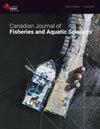生命周期模型显示,濒危野生大鳞大麻哈鱼通过提高洄游存活率具有很高的恢复潜力
IF 2.2
2区 农林科学
Q2 FISHERIES
Canadian Journal of Fisheries and Aquatic Sciences
Pub Date : 2023-12-05
DOI:10.1139/cjfas-2023-0167
引用次数: 0
摘要
哥伦比亚河流域的奇努克鲑鱼(Oncorhynchus tshawytscha)受到迁徙走廊、河口和出生栖息地的人为变化的威胁。溪流为鲑鱼产卵和饲养生命阶段提供了空间异质性的出生栖息地。本文拟合了爱达荷州中叉鲑鱼河(MFSR)鲑鱼种群的统计状态-空间模型,以评估出生生产力和种群增长的空间变化。我们的模型整合了多个长期数据集来估计人均幼崽产量和幼崽到成年(SAR)存活率的变化。幼崽产出量因河段而异,平均为104.48只雌崽产出量为每只雌崽产出量为0.74%。支努克鲑鱼种群增长率超过更替率的比例为17%(23条中的4条)。通过将SARs增加到1.8%(接近哥伦比亚河流域恢复目标的下限),我们预测在当前(非常低的)产卵密度下,所有23个MFSR段将产生正的种群增长率。我们的分析表明,对于高质量出生栖息地内的蛇河流域种群,SAR的改善将提高鲑鱼种群的增长率,并促进濒危野生奇努克鲑鱼的恢复。本文章由计算机程序翻译,如有差异,请以英文原文为准。
Life-cycle modeling reveals high recovery potential of at-risk wild Chinook salmon via improved migrant survival
Chinook salmon (Oncorhynchus tshawytscha) in the Columbia River basin are threatened by anthropogenic changes to migratory corridors, estuaries, and natal habitats. Streams provide spatially heterogeneous natal habitats essential for salmon spawning and rearing life stages. We fit a statistical state-space model to salmon populations in Idaho’s Middle Fork Salmon River (MFSR) to assess spatial variation in natal productivity and population growth. Our model integrated multiple long-term data sets to estimate variation in per-capita smolt production and smolt-to-adult (SAR) survival. Smolt production varied across stream segments, averaging 104.48 female smolts per spawning female, while SARs averaged 0.74%. Chinook salmon population growth rates exceeded replacement in 17% of segments (four of 23). By increasing SARs to 1.8% (near the lower bound of Columbia River basin recovery targets), we predict that all 23 MFSR segments will yield positive population growth rates at contemporary (very low) spawner densities. Our analysis suggests that for Snake River basin populations within high-quality natal habitats, SAR improvements will elevate salmon population growth rates and enhance restoration of at-risk wild Chinook salmon.
求助全文
通过发布文献求助,成功后即可免费获取论文全文。
去求助
来源期刊

Canadian Journal of Fisheries and Aquatic Sciences
农林科学-海洋与淡水生物学
CiteScore
4.60
自引率
12.50%
发文量
148
审稿时长
6-16 weeks
期刊介绍:
The Canadian Journal of Fisheries and Aquatic Sciences is the primary publishing vehicle for the multidisciplinary field of aquatic sciences. It publishes perspectives (syntheses, critiques, and re-evaluations), discussions (comments and replies), articles, and rapid communications, relating to current research on -omics, cells, organisms, populations, ecosystems, or processes that affect aquatic systems. The journal seeks to amplify, modify, question, or redirect accumulated knowledge in the field of fisheries and aquatic science.
 求助内容:
求助内容: 应助结果提醒方式:
应助结果提醒方式:


